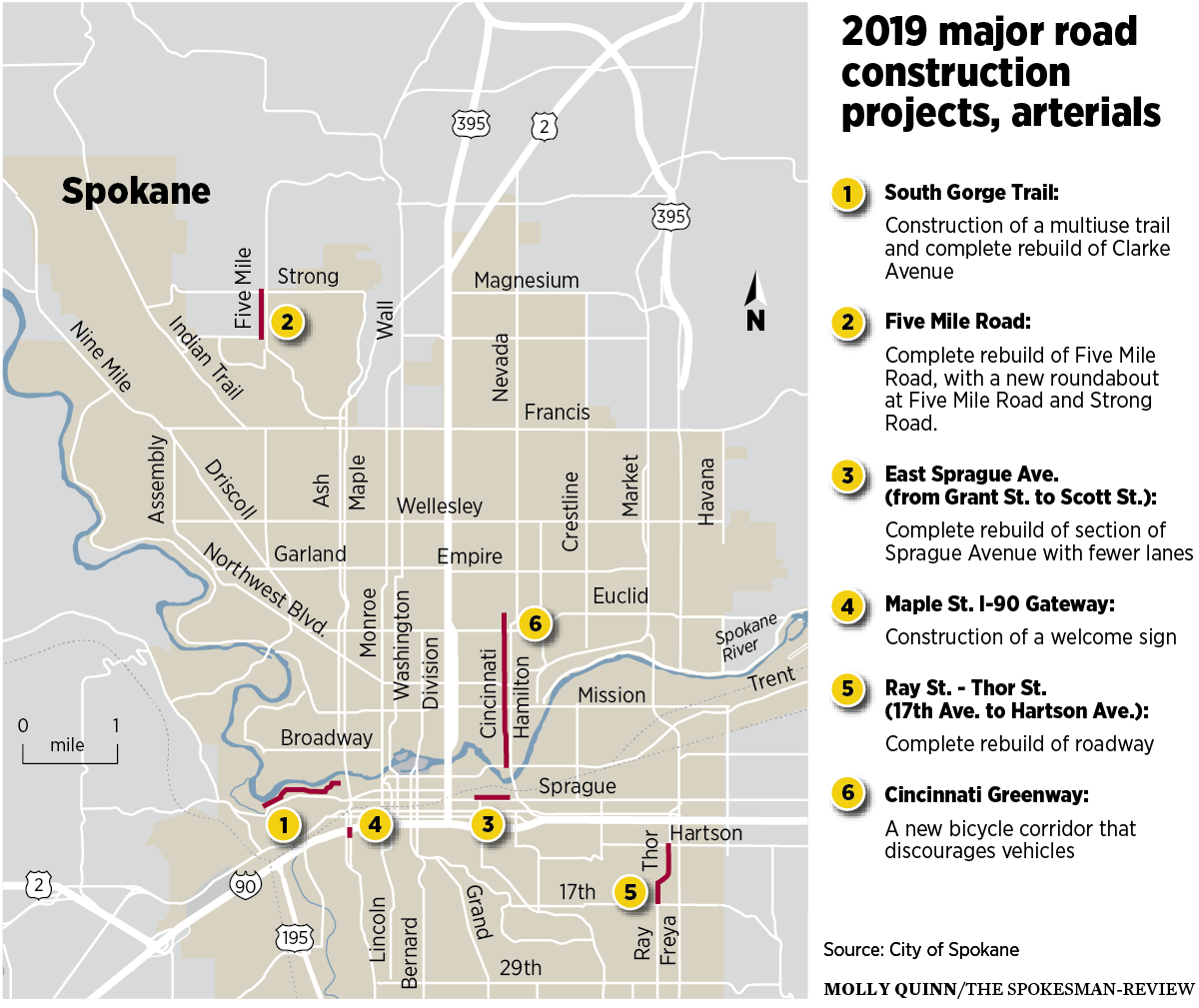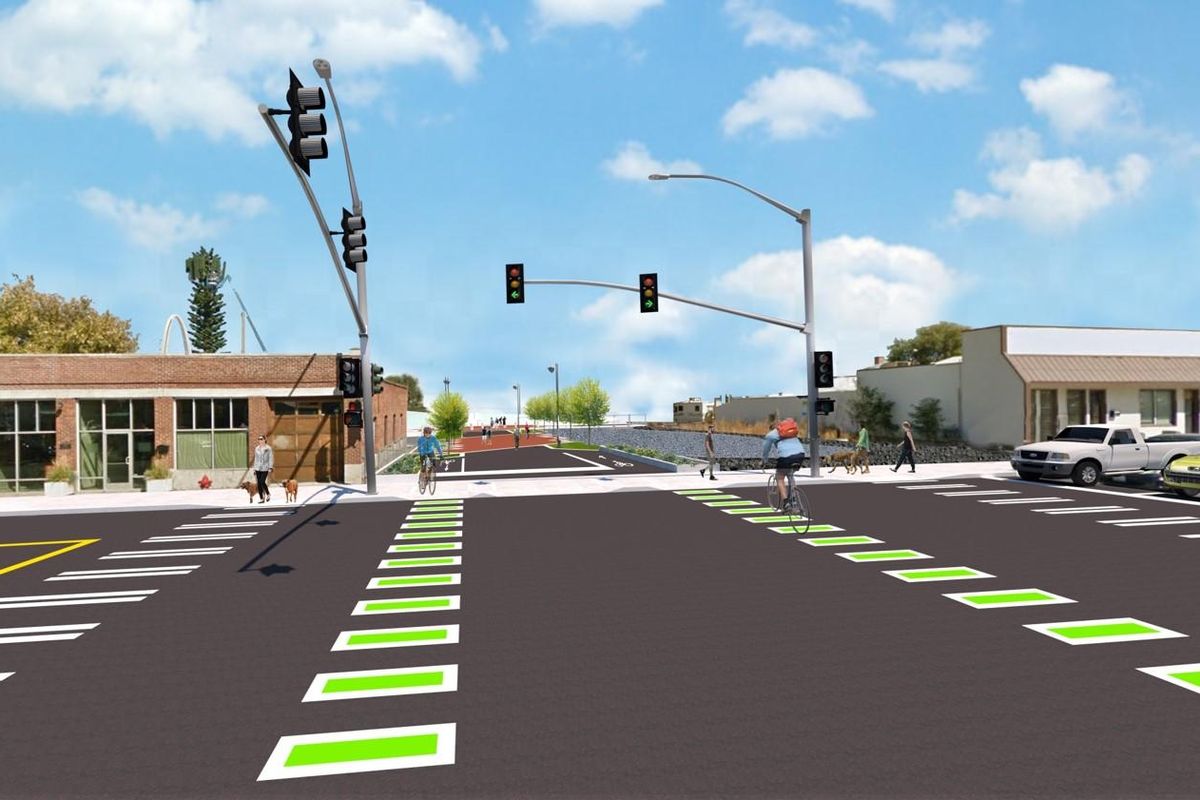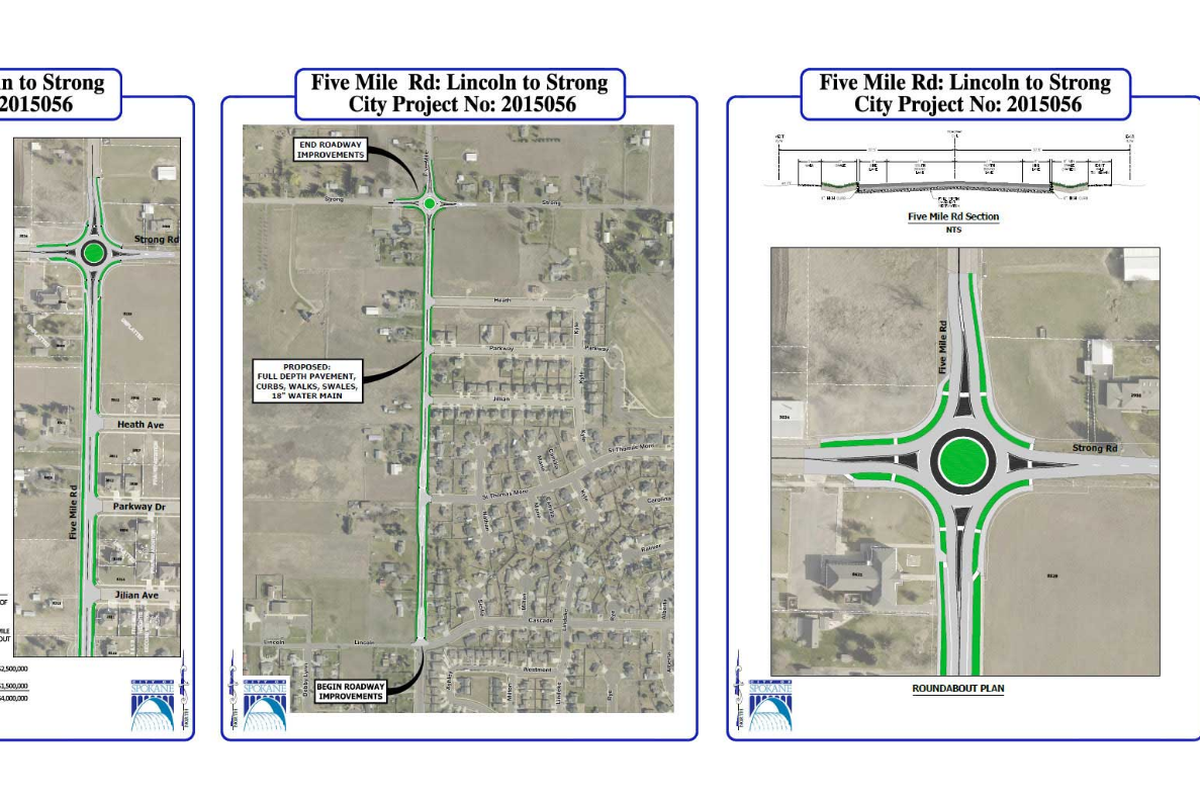Getting There: Six big road projects that could smooth (or beautify) your commute in Spokane this year
Now that the University District Gateway Bridge is complete, the city is working to improve the nearby intersection of East Sprague Avenue and South Sherman Street. (Courtesy City of Spokane)
One hundred years and some days ago, the Spokane Daily Chronicle blared a headline across the top of its front page: “Will Spend Millions On Northwest Roads.”
The day was Jan. 8, 1919, and the federal government said it was going to spend $300 million on the nation’s roads. But below the fully capitalized banner headline, there were other stories of note. One reported that Leon Trotsky had jailed “Nicolai Lenine, the bolshevist premier of Russia,” who we know better as Vladimir Lenin, the founding father of the Soviet Union. Another relayed the story of a mother and her two young sons dying in a house fire in Colville. And one more told of Theodore Roosevelt’s funeral, under the headline, “Earth Receives Mortal Remains of the Colonel.”
But the banner said it all. Road work, especially given such an outlay, was the news of the day.
A century later, we’re used to spending gobs of cash on roads. In 2015, state and local governments in the U.S. spent $168 billion on highways. That same year, Gov. Jay Inslee and Washington’s legislators agreed to increase the gas tax by 11.9 cents per gallon, raising $16 billion over 16 years, most of which will go toward state highways and local roads.
This year, the city of Spokane will spend $15.2 million on six notable projects. So, really, 100 years on, that 1909 headline might as well run again.
Five Mile Road
Way up north, there’s a neighborhood and a bluff we call Five Mile. It’s gotten quite popular to live there, and the city’s road-builders are trying to keep up. In 2017, the city paved – really, made – Barnes Road, from Strong Road to Phoebe Street. The old dirt road was finally given a modern surface, with sidewalks, swales, landscaping and bike lanes. For the first time, the folks of Five Mile Prairie had a direct route to Indian Trail.
This year, the work continues with a $4 million project to completely rebuild Five Mile Road from Lincoln Road to Strong, where a roundabout will be built.
The work – paid for with a mix of state and local arterial street funds – also will bring better pedestrian lighting, crosswalks at every intersection, swales, trees and the replacement of an 18-inch steel water main below the road.
Five Mile Road sees an average of 5,900 vehicles a day.
Clarke Avenue and South Gorge Trail
Peaceful Valley residents just spent the last construction season getting used to not having Main Avenue as a connection to downtown.
This year, the only other route out of the neighborhood will see major work, which will affect commutes.
A complete rebuild of Clark Avenue from Elm Street to Riverside Avenue is on deck. The $3.5 million project will bring new pavement and a new water main, and it will be done in concert with more work to complete the South Gorge Trail.
The 10-foot-wide multiuse trail will run from the parking lot at People’s Park near the Sandifur Bridge to Redband Park, which was until recently known as Glover Field. Sometimes the paved trail will be separate from the road, other times it will just be a very wide sidewalk.
But when it’s done, well, there still will be more to do. The city is working to finish the last section of the trail, which eventually will be a 3-mile loop running through Peaceful Valley, Kendall Yards and Riverfront Park. The last bit to be done is the link between Redband Park and the tank being built just north of the downtown Spokane Public Library, which will be topped with a pedestrian plaza.
“The only piece we’ll have left then is Redband up to the plaza tank,” said Marlene Feist, a city spokeswoman, adding that the completion of the trail is years off, but current city thinking has it going behind the Spokane Club and under the Monroe Street Bridge.
East Sprague Avenue
East Sprague Avenue is a major road into downtown, and has been since the city’s early days.
Though its surface was allowed to deteriorate in recent decades – and was last improved in 1985 – the city is rebuilding stretches of the road, one year at a time. In 2019, the section between Grant and Scott will see major changes.
Though Sprague is a designated truck route, and carries a Spokane Transit Authority line, the city has a stated goal of creating a “safer, calmer and more attractive Sprague Avenue.”
That means new sidewalks and new pavement, taking the street from four lanes to two and a center turn lane, and putting in infrastructure for its use as a part of STA’s “high performance transit network” with new, elevated shelters. The project also will replace a water transmission pipe below the street that’s been in use since 1894.
What’s not coming to Sprague is better bikeways, despite it being at the landing of the new $15.4 million bicycle and pedestrian bridge connecting Sprague to the University District. Instead, the city will encourage bicyclists to share the lane with vehicles, or find a back street to ride on.
Ray/Thor
This $3 million project will completely rebuild Ray and Thor streets from 17th Avenue to Hartson. The project is paid for with local funding, and will bring major impacts to commuters who use the principal South Hill routes when it begins this spring.
The project, which also will replace utility infrastructure, is expected to be complete in the fall.
Cincinnati Greenway
More than three years after the Spokane City Council funded it, the Cincinnati Greenway is coming to town.
This summer, the $700,000 project will commence with various traffic calming and vehicle diversionary measures to create the bike corridor. When complete, the road will be kind of a pain to drive on, but very nice to ride a bike or walk on. Greenways go by other names in other cities: bicycle boulevard, neighborway and neighborhood byway, to name a few.
The 1.7-mile route will connect to the Centennial and Ben Burr trails and the Addison-Standard bike corridor on Spokane’s North Side.
Though a city project, for a time it was in the hands of Gonzaga University engineering professor Rhonda Kae Young and her students. They did a lot of early design and consultant work, which they handed over to city engineers last year.
In an interview last year, Young described greenways as routes where cars still are allowed but built to slow traffic – like the skinny streets of the South Hill.
“Some people say, ‘I don’t like those streets and I try to avoid them.’ And that’s what we want,” Young said, noting that speed is kept below 20 mph and it’s “not a road that feels comfortable going 35 mph.”
Funding for this project is a mix of local money that comes from the city’s Transportation Benefit District, which is funded by the $20 annual fee on vehicle registration, and a federal clean air grant.
Maple Street I-90 Gateway
This $500,000 project is intended to make Maple Street below Interstate 90 a bit more welcoming, and more like the “gateways” some of the other interstate ramps have in Spokane, with a giant “City of Spokane” sign.
“It is about beautification more than anything else, to enhance the entrance off of I-90,” Feist said.
Delayed 2019 projects
Two projects intended to be done this year have been delayed.
Replacement of the Post Street Bridge near Riverfront Park has been put off at least a year after the city decided to scrap its plan to use a progressive design-build contract.
Such a contract would’ve used the same company to design and build the bridge, and was pitched as way to streamline the work. Then the city heard the cost estimate for what it would take to replace the aging structure: $26 million.
“It’s over cost,” Feist said. “The guaranteed maximum cost was $26 million. That was $4 million more than we expected, so we want to see what else we can get out of that.”
So now it’s back to the drawing board, as the city completes the design and goes out for a competitive bid on the bridge rebuild. First, since the project is being paid for with federal funds, the city has to get permission from the federal government.
The city also had planned a $4 million project on the Hamilton corridor.
This project, which has been on the books since 2010 but only recently got a federal Congestion Mitigation Air Quality Program grant to pay for it, would’ve installed new traffic signals at all intersections on Hamilton with protected left-turn lights. The idea was to create better traffic flow in an effort to reduce congestion.
The city will replace two sections of water main under the road – from Trent to the pedestrian overpass, and then the overpass to Desmet – but the signalization is pushed back to 2020 and 2021.
“There’s a bunch of work that needs to happen there first,” Feist said. “The Hamilton bridge was in worse shape than they thought, so they’ll have to do more work on that on-ramp” before the city work starts.
Grind and overlay
Besides the big projects, the city will continue is maintenance of existing roadways:
- East Sprague Avenue – Scott to Helena.
- Regal Street – 29th to 39th avenues.
- Freya Street – 27th to 37th avenues.
- Wellesley Avenue – Nevada to Pittsburg streets.
- Addison Street – Garland to Rowan avenues.
- Stevens Street – Third Avenue to Spokane Falls Boulevard.
- Northwest Boulevarld and Indiana Avenue – Maple to Lincoln streets.
- Cowley Street – Fourth to Seventh avenues.
- Maple and Ash streets – Rowan Avenue to Country Homes Boulevard.
- Wellesley Avenue – Driscoll Boulevard to Milton Street.
Ban studded tires?
Last week, The Spokesman-Review reported that state Rep. Cindy Ryu, D-Shoreline, has sponsored a bill that, if passed, would institute a $100 fee on the purchase of studded tires, collecting a total of $400 for a set of four new tires. Her bill, which is being considered by the House Transportation Committee, would ban the tires after mid-2025.
Ryu’s proposal would replace the current $5 fee and eventually phase out studded tires. The fee would raise an estimated $3.5 million over the next two years – but that wouldn’t make up for the estimated damage to state roads that a state Department of Transportation study puts at about $24.5 million.




